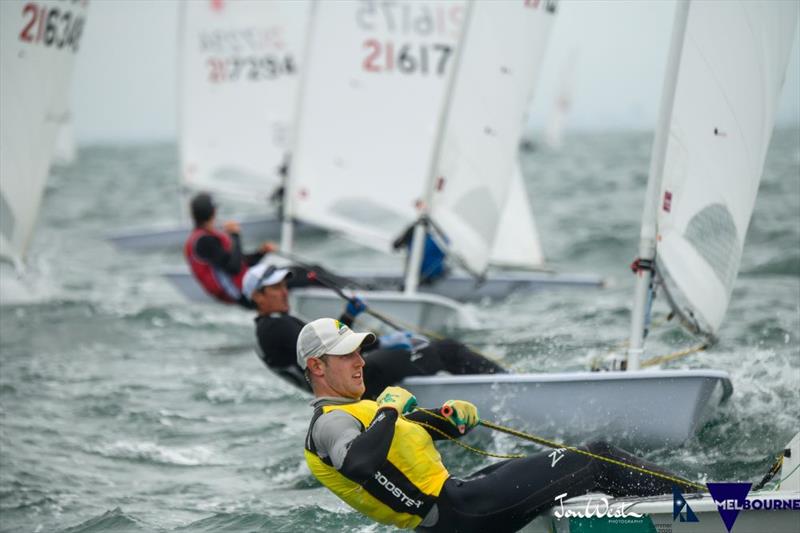
An interview with James Mitchell about the 2020 Laser Worlds
by David Schmidt 7 Feb 2020 05:00 NZDT
February 9-16, 2020

Matt Wearn keeps his full-rig Laser flat and going fast © Jon West
When it comes to One Design sailing, it’s hard to find a better test of a male sailor’s fitness and on-the-water strategy, tactics and overall acumen than the standard-rig Laser, which was designed by Bruce Kirby (CAN) in 1970. While this design isn’t new, it’s easily one of the world’s most popular One Designs, with fleets racing competitively almost anywhere one can find water and wind.
In additional to its longstanding popularity and the athletic prowess required to keep the boat flat and moving fast in all airs, the Laser became an Olympic class boat ahead of the Atlanta 1996 Olympics. This ushered in new generations of sailors and has helped keep the class at the forefront of high-performance sailing ever since.
This move also placed additional pressures on the class’ world-championship regattas, which are often used by countries (e.g., the United States) in determining who will represent a country’s flag at the Olympic Games. Moreover, all gold-medal hopefuls understand the importance of sailing fast and placing well at a world-championship-level regatta ahead of the Games.
Given that 2020 is an Olympic year, you can bet your last roll of duct tape that this year’s Laser Worlds (February 9-16, 2020) will be one of most competitive Laser Worlds in recent memory. Adding to this impressively steep hill that all competing athletes must negotiate is the fact that—unlike the Olympic Games—countries can send multiple representatives to the Worlds.
This year’s Laser Worlds and Laser Radial Worlds (stay tuned for a pre-regatta interview on this equally hot event) are being hosted by Sandringham Yacht Club, the Australian Laser Association and local community groups, and will be contested on the waters off of Melbourne, Australia. I checked in with James Mitchell, who serves as event chair of the 2020 Laser Worlds, via email, to learn more about this high-level One Design world-championship regatta.
How many boats are you expecting on the starting line?
140 boats, very close to our regatta cap of 160. Obviously, the timing of the regatta being a few months before the Olympics has encouraged the best to be here in Melbourne.
Do you have your eye on any pre-racing favorites? What about any dark horses?
Well Tom Burton (AUS) is ranked Number 1 by World Sailing with Matthew Wearn (AUS) ranked #2. With Wearn being selected as the Australian representative for the Tokyo Olympics we are really looking forward to seeing them both battle it out at our Worlds.
The question is, will this be the last time we see them go head to head in Lasers? Having said that the fleet reads like a who’s who of Laser Standard sailing.
Personally, I can’t wait to see Robert Scheidt in action.
How would you describe competition levels at the event compared to a laser World regatta from, say, the mid-70s/mid-80s?
Are you kidding! Every year the bar is raised. The vast majority in this regatta will be full-time athletes. Many have been in Melbourne for the last two months sailing in everything from five to 40 knots.
How important do you think local knowledge will be at the regatta?
Very little for three reasons. One - there is not much tide; two - the sea breeze does clock to the left, except when it pays on the right!; and three, as I said they have been here for months, they are the “locals”.
If you could impart one piece of local wisdom to visiting sailors, what would it be?
I’m not teaching them how to sail–my advice would be–walk the coastal path northwards one morning and southwards the next, great views along the wonderful Port Phillip coastline. Oh, and there’s plenty of restaurants in Sandy Village and good food at the Club too.
What kind of weather conditions can sailors expect? What are the best-case and worst-case scenarios?
I’m praying for the summer sea breezes, a southwester which builds on a warm/hot day from 1000 hours through the afternoon, with an accompanying short chop that develops into full rolling waves by late afternoon.
The southeasterlies and northerlies are flat water off shore breezes–not quite as spectacular but in many ways more challenging. It’s all good.
Can you tell us about any steps that you and the other event organizers have taken in the last couple years to help green-up the regatta or otherwise lower its environmental wake?
We have worked really closely with our hosts the Sandringham Yacht Club, the Australian Laser Association and local community groups to take practical steps to reduce the regatta impacts and use the events as a catalyst for change. Too many initiatives to mention really, but for example we have built a high-volume chilled water dispenser to encourage the use of refillable water containers; banned single-use plastic bottles and straws; run educational campaigns with local primary schools, and had the local harbor cleaned up.
We have some more announcements coming on that front too.
Anything else that you’d like to add, for the record?
The local Laser District has taken the financial risk in running this event and the others in the Summer of Laser Sailing 2020. It’s an event run by a group of passionate volunteers for the sailors who love Laser sailing in Melbourne.